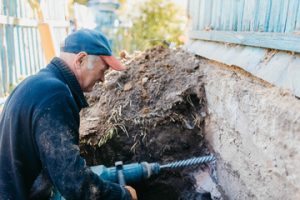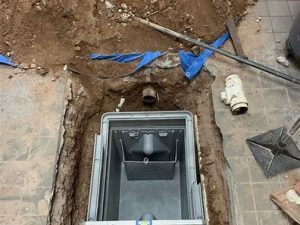Foundation Repair Nashville involves identifying, assessing, and addressing issues like cracks, leaning walls, or bowed floors. Detecting these signs early is essential in reducing costs and safeguarding the integrity of your home.

There are many different foundation repair methods, from filling minor cracks to reseating sinking slabs. Some of these techniques require professional input to guarantee optimal results.
Concrete piers are a common solution for fixing foundation damage to a pier-and-beam or slab-on-grade foundation. They are sturdy, affordable, and effective at transferring load to the soil underneath. They are also one of the most versatile solutions for repairing a concrete foundation, and can be customized to meet the needs of any specific project or situation.
Like their name suggests, concrete piers are constructed from thick, strong concrete, making them a perfect choice for heavy loads. These unique structural supports are also more affordable than other types of piers, and have a long lifespan. Unlike steel, concrete is not susceptible to corrosion or rust, which means that concrete piers can last well beyond the lifetime of your home if properly maintained.
The main advantage of using concrete piers for your foundation repair is that they can be installed with minimal disruption to your home. Concrete piers can be driven into the ground beneath your home with hydraulic pressure from a mobile crane, meaning that there is no need to excavate or dig holes in your yard or around your foundation. This makes them a popular option for homeowners who are looking to repair their foundation without causing any major disturbance to their property or daily routine.
Concrete piers can be used to repair a wide range of problems, including sinking, shifting, and cracking foundations. They are particularly well-suited for repairing pier-and-beam foundations that have suffered from settlement, cracking, and sinking due to soil subsidence or sinkholes. They can also be used to fix sagging or buckling crawl space floors, as well as misaligned doors and windows that indicate foundation movement.
When choosing a professional to install your concrete piers, look for one who has extensive experience with foundation repair and can provide you with a free consultation and quote. Ask the professional about their track record, years in the business, and any specialized certifications or training that they have received. You should also check out the warranty that they offer for their work, as this will indicate how confident they are in the quality of their services and products.
Steel Piers
Foundation piers are one of the most effective ways to repair a house’s foundation and prevent future shifts and displacement. It’s important to choose the right type of piers for your situation, though. There are three common types of piers: concrete, steel and helical. The type of pier that’s best for your foundation is dependent on a variety of factors, including soil movement and conditions, structural load requirements and extent or severity of the problem.
When the time comes to fix a sinking or shifting foundation, many homeowners aren’t sure which solution is best. Fortunately, there are several options available to meet each homeowner’s unique needs and soil conditions. For example, concrete piers can be a great option for homes in the Dallas-Fort Worth area with expansive clay soils, while steel piers are better for projects that require deep support or those at risk of significant movement and settling.
Regardless of which pier system you choose, your HD Foundations expert will carefully inspect your foundation to assess the extent and severity of the problem. They’ll also perform thorough soil testing to determine the best pier type for your project. This process ensures the right amount of force is applied to the soil and that your home’s foundation will be adequately supported for years to come.
Once the piers are in place, the building’s weight gets transferred to them, and your foundation starts to stabilize. The piers may then be used to restore the original elevation of your foundation, or you can install them to support porches, decks, patios, hot tubs and pre-fab buildings.
As a bonus, compared to other foundation repair methods, installing steel piers typically involves less disruption to your property. Thanks to their hydraulic driving method, the piers can be inserted into the ground without needing to excavate or disturb your landscaping. Plus, their durable construction and long-term performance make them a cost-effective investment that can help you save money on future repairs.
Slab Jacking
Slab jacking can be less expensive than underpinning, but it’s still not inexpensive. This repair method involves drilling holes in your foundation and pumping mud into the soil beneath to raise the slab back up to its original level.
Over time, the soil beneath your foundation can shift due to changes in weather conditions. This can lead to uneven floors, doors and windows that don’t close properly, cracks in the walls and other structures of your home, and more. The most common reason for this shifting is long periods of drought that cause the soil to shrink, leaving voids underneath your foundation.
When these voids are left unaddressed, your slab foundation may sink or bow over time. This can leave your home unstable and unsafe, and it’s essential to find a way to correct these issues. If you’ve noticed your concrete slab is sagging, you can hire a professional to relevel it through either mudjacking or poly slab jacking.
Both methods involve drilling holes in your concrete slab and injecting a material to raise it back up to its original position, but they have different techniques and materials. Mudjacking uses a cement slurry, which is pumped into the soil through these holes to fill any voids and lift the foundation slab. Poly slab jacking, on the other hand, uses a high-density foam to lift and stabilize your sunken slab.
Unlike mudjacking, poly slab jacking doesn’t require waiting for the concrete to cure after installation. It’s also less invasive and causes minimal disruption to your daily activities, so you can use the repaired area almost immediately.
Slab jacking isn’t a permanent solution, but it can be a good option for homeowners who want to avoid the costly expense of replacing their slab foundations. It’s important to keep in mind, however, that the sunken slab is most likely to sink again in the future unless you address the underlying issue. If you have other problems with your foundation, such as water intrusion or extensive tree roots, you’ll need to have those addressed before considering this repair method again.
Underpinning
The term “underpinning” refers to a building or structure’s foundation footings being reconstructed to support it more effectively. This technique can be used to repair a foundation that has settled or is unstable for many reasons. Generally, structural changes, changes in a building’s use, or additions of floors to existing buildings can cause new loads that strain the original foundation design. Underpinning can redistribute these heavier loads and strengthen the original foundation to prevent further sinking or structural damage.
Traditionally, underpinning was accomplished by replacing the old foundation footings with more robust concrete or steel. This type of underpinning can be very costly and disruptive to the home as it requires the excavation of large sections of the yard. More recently, underpinning has been accomplished using a minimally invasive technique called resin injection underpinning. Resin injection underpinning involves injecting a mixture of hardener and resins into the ground of the foundation, underneath the existing footings. The expanding nature of the resin will fill voids and increase the footing’s bearing capacity, which helps to stabilize the foundation.
Regardless of the underpinning technique, prompt action is essential if you suspect you have a foundation problem. Watching for hairline cracks in your walls and sloping floors is a good indicator of a shifting or failing foundation. If these problems go unchecked, they can lead to severe structural damage and render your home unsafe or even uninhabitable.


